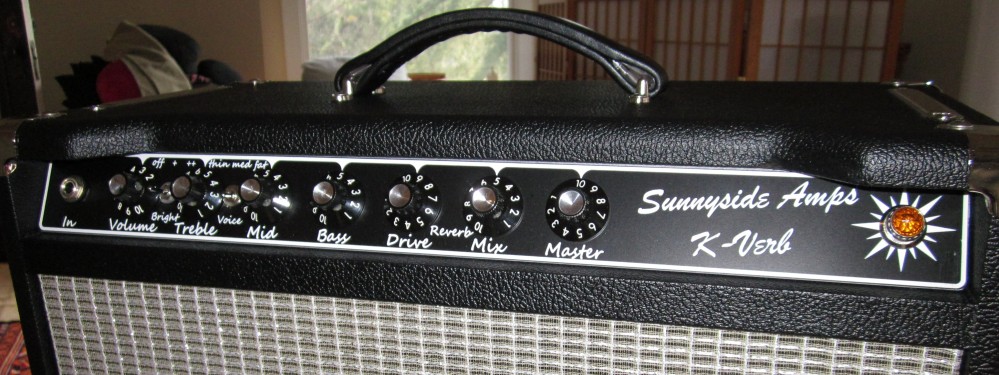After a year of experimentation,prototyping and refining, the Sunnyside K-verb 40 and 50W amplifiers are ready…and they sound great! If you like beautiful clean tones, reverb, and an amp that takes pedals well, then you will love these amps! Just pick the one with the right wattage for your needs are you will have years and years of great tone!
pay now, or pay later
You go out and purchase a brand new, inexpensive guitar amplifier with cost-efficient PCB constructiion. It seems, at first, to be a great deal! A new guitar amp, with channel switching, and reverb, for less than $1000! Unfortunately the manufacturer cut corners and used inexpensive construction techniques that are easy to mass-produce, and keep the selling price low. But, wait till you have to fix the amp (and you surely WILL have to fix it often)–your repaitr costs will be quite high due to the more time-consuming nature of having to repair these amps. In many, if not most, of these new amps, the solder joints are on the underside of a printed circuit board, and to get to those points to enact the needed reapirs requires a time-consuming partial dissassembly of the internals of the amplifier. So, the “great deal” you thought you had ends-up possibly costing you more (due to labor costs) than if you had bought a higher quality amplifier in the first place.
Converting old two-prong cords to 3-prong
A lot of vintage amps have a two-pronged power cord. Here is my position on this: If you bring in an amp to me with a two-prong cord I am going to insist that you have me install a properly grounded three prong cord. Here’s why: In the case of a two-prong AC cord, in the advent that the 120V AC wire gets loose inside the amp and rests against the metal chassis, it will make the chassis of the amp possibly lethal (and at the very least increbibly painful and injurious) to touch. With a properly wired three-prong cord the above scenario (the “live” wire getting loose inside the amp and touching the chassis) would short the 120V AC wire to ground, and blow the amplifiers main fuse. Fuse blown, nobody hurt. That’s because the chassis (due to the new three prong cord) now has a direct connection to ground (earth) provided through the third prong. I take keeping my fellow musicians safe seriously!
Re-cap jobs
The Electrolytic capacitors used to filter the power supply in your amplifier have a limited lifetime.They need to be periodically replaced. When they get very old I have seen them become a short. This is disastrous because it can damage other components in the amplifier. Example: I had an old Sears Silvertone amp in the shop where the power suppy filter choke started to smoke (and was destroyed) because one end of the choke was shorted to ground by an old failed electrolytic cap. Think about it: One end of the choke was at 400V, the other at ground….. Smoked! So, when I go through your amp I am always on the lookout for old electrolytic caps that need to be replaced. Replacing these caps is a normal part of the amplifiers
maintenance cycle and does not change the tone of your amplifier (although
replacing old worn electrlytics can bring the amp to life!). What DOES change
the tone of the amp is changing the coupling caps in the amp. This is something
we will not do unless one of the caps is malfunctioning (Leaking). So, don’t get
nervous if we say you need a cap job!
